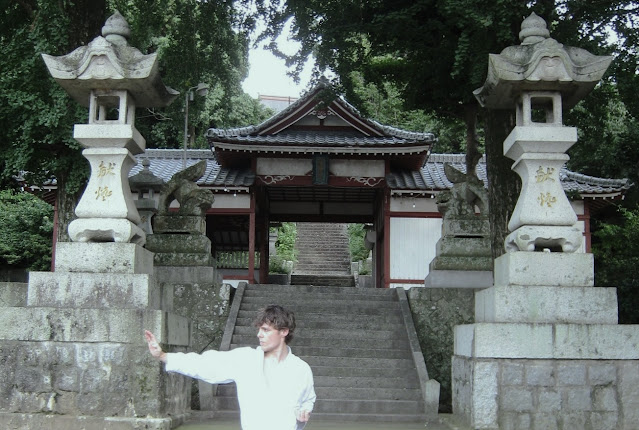HOW TO DO:
(A) Karada no buki
Firstly tateshuto (the vertical sword hand) must be properly formed. This encompasses the level connection of all four digits with the thumb aligned on the side of the hand, and bent at 90 degrees. With this basic form, the strong bending at the wrist, with the fingers pointing vertically as much as possible, constitutes a proper tateshuto. The striking surface—on the outside edge of the hand—runs from just below the base of the small finger to 青龍刀 (Seiryuto).
(B) Waza
From shizentai with ryoken daitai mae (hachiji-dachi or heiko-dachi) slowly assume hidari tateshuto chudan-gamae: uken migi koshi. Do this by:
1. Loading
hidari tateshuto at the right wakibara whilst tightly wrapping the right first
to the left tricep (with the back of the fist facing upwards).
2. Slowly
swing the left tateshuto inside-outward to the inside crease of the left
shoulder—the height of the arm should be with “the top of the arm basically
inline, with the top of the shoulder, but with a slight incline”; whilst,
simultaneously, the right fist is withdrawn to the right hip (uken migi koshi).
If in doubt, the key is to make the longest horizontal action as possible
without compromising form. It is important that the tateshuto arm is straight;
nevertheless, an externally imperceptible bend in the elbow must be maintained.
HOW TO APPLY:
This kamae/waza while mostly performed slowly (in kata and as a preparatory position in kihon) is obviously applied with maximum speed in application. It’s power is “…optimally derived from a swing as opposed to snap”, yet there are exceptions. One such example is 雲手型 (Unsu kata): movements eight, ten, 12 and 14.
The prime 応用 (Oyo) of this waza is from a clinch with an opponent. Wrap over the top of their arm(s)—ensuring to do so on their blindside—and then generically impact to the neck with a large scale ‘furi-uchi’. This is most effectively applied by dropping the weight, just as prescribed in kata, as it causes the opponent to also drop; that is, like so often, “…chudan becomes jodan”.
© André Bertel. Oita City, Japan (2022).

No comments:
Post a Comment